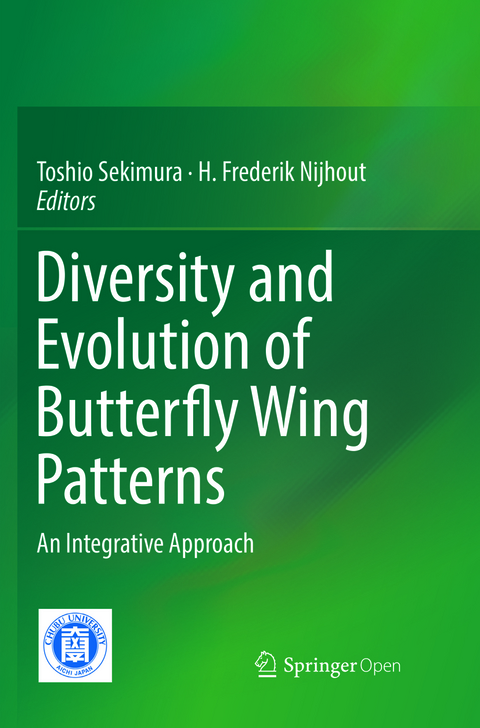
Diversity and Evolution of Butterfly Wing Patterns
Springer Verlag, Singapore
978-981-13-5275-1 (ISBN)
The past decade-and-a-half has seen a veritable revolution in our understanding of the development, genetics and evolution of butterfly wing patterns. In addition, studies of how environmental and climatic factors affect the expression of color patterns has led to increasingly deeper understanding of the pervasiveness and underlying mechanisms of phenotypic plasticity. In recognition of the great progress in research on the biology, an international meeting titled “Integrative Approach to Understanding the Diversity of Butterfly
Wing Patterns (IABP-2016)” was held at Chubu University, Japan in August 2016. This book consists of selected contributions from the meeting. Authors include main active researchers of new findings of corresponding genes as well as world leaders in both experimental and theoretical approaches to wing color patterns.
The book provides excellent case studies for graduate and undergraduate classes in evolution, genetics/genomics, developmental biology, ecology, biochemistry, and also theoretical biology, opening the door to a new era in the integrative approach to the analysis of biological problems.
This book is open access under a CC BY 4.0 license.
Toshio Sekimura, Professor Department of Biological Chemistry, Chubu University, Kasugai, Aichi 487-8501, Japan H. Frederik Nijhout, Professor Department of Biology, Duke University, Durham, NC 27708, USA
Foreword.- Preface.- Contributors.- Part I. The Nympalid Groundplan (NGP) and Diversification.- Chapter1:The common developmental origin of eyespots and parafocal elements;And a new model-mechanism for color pattern formation.- Chapter2:Exploring color pattern diversification in early lineages of Satyrinae (Nymphalidae).- Chapter3:Camouflage variation on a theme of the Nymphalid Ground Plan.- Chapter4:Morphological evolution repeatedly caused by mutations in signaling ligand genes.- Part II. Eyespots and Evolution.- Chapter5:Physiology and evolution of wing pattern plasticity in Bicyclus butterflies: a critical review ofthe literature.- Chapter6:Spatial variation in boundary conditions can govern selection and location of eyespots inbutterfly wings.- Chapter7:Self-Similarity, Distortion Waves, and the Essence of Morphogenesis: A Generalized View ofColor Pattern Formation in Butterfly Wings .- Part III. Developmental Genetics .- Chapter8:A practical guide to CRISPR/Cas9 genomeediting in Lepidoptera.- Chapter9:What can we learn about adaptation from the wing pattern genetics of Heliconiusbutterflies?.- Chapter10:Molecular mechanism and evolutionary process underlying female-limited Batesian mimicry in Papilio polytes.- Part IV. Ecological Aspects and Adaptation.- Chapter11:Chemical Ecology of Poisonous Butterflies: Model or Mimic?— A Paradox of Sexual Dimorphisms in Müllerian Mimicry.- Chapter12:A model for population dynamics of the mimetic butterfly Papilio polytesin Sakishima Islands, Japan (II).- Chapter13:Evolutionary trends in phenotypic elements of seasonal forms of the tribe Junoniini(Lepidoptera: Nymphalidae).- Chapter14:Estimating the mating success of male butterflies in the field.-Part V. Color Patterns of Larva and Other Insects.- Chapter15:Molecular Mechanisms of Larval Color Pattern Switch in the Swallowtail Butterfly.- Chapter16:Drosophila guttifera as a model system for elucidating color pattern formation.- Chapter17:Molecular mechanisms underlying color vision and color formation in dragonflies.
| Erscheint lt. Verlag | 12.12.2018 |
|---|---|
| Zusatzinfo | 89 Illustrations, color; 14 Illustrations, black and white; XII, 321 p. 103 illus., 89 illus. in color. |
| Verlagsort | Singapore |
| Sprache | englisch |
| Maße | 155 x 235 mm |
| Themenwelt | Mathematik / Informatik ► Mathematik ► Angewandte Mathematik |
| Naturwissenschaften ► Biologie ► Evolution | |
| Naturwissenschaften ► Biologie ► Genetik / Molekularbiologie | |
| Naturwissenschaften ► Biologie ► Zoologie | |
| Schlagworte | Color patterns • Development • Ecology • Evolution • Eyespots • Genetics • mathematical model • mimicry • Nymphalid groundplan • open access • Reaction-diffusion |
| ISBN-10 | 981-13-5275-5 / 9811352755 |
| ISBN-13 | 978-981-13-5275-1 / 9789811352751 |
| Zustand | Neuware |
| Informationen gemäß Produktsicherheitsverordnung (GPSR) | |
| Haben Sie eine Frage zum Produkt? |
aus dem Bereich


